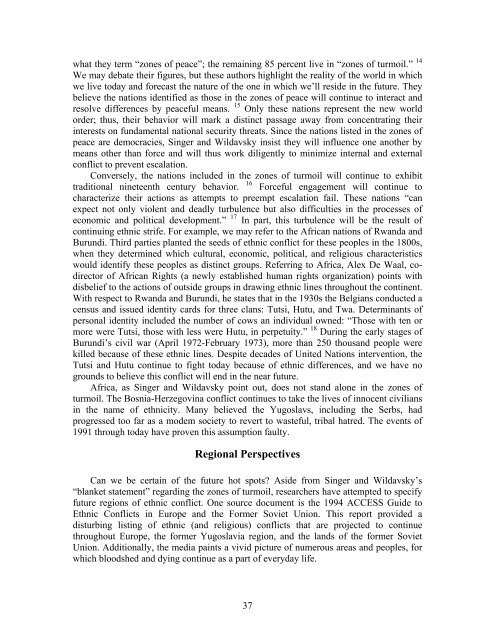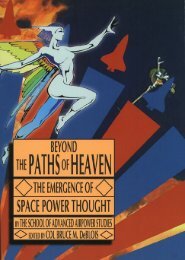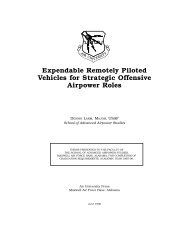Global Security Concerns - Project Gutenberg Consortia Center
Global Security Concerns - Project Gutenberg Consortia Center
Global Security Concerns - Project Gutenberg Consortia Center
You also want an ePaper? Increase the reach of your titles
YUMPU automatically turns print PDFs into web optimized ePapers that Google loves.
what they term “zones of peace”; the remaining 85 percent live in “zones of turmoil.” 14<br />
We may debate their figures, but these authors highlight the reality of the world in which<br />
we live today and forecast the nature of the one in which we’ll reside in the future. They<br />
believe the nations identified as those in the zones of peace will continue to interact and<br />
resolve differences by peaceful means. 15 Only these nations represent the new world<br />
order; thus, their behavior will mark a distinct passage away from concentrating their<br />
interests on fundamental national security threats. Since the nations listed in the zones of<br />
peace are democracies, Singer and Wildavsky insist they will influence one another by<br />
means other than force and will thus work diligently to minimize internal and external<br />
conflict to prevent escalation.<br />
Conversely, the nations included in the zones of turmoil will continue to exhibit<br />
traditional nineteenth century behavior. 16 Forceful engagement will continue to<br />
characterize their actions as attempts to preempt escalation fail. These nations “can<br />
expect not only violent and deadly turbulence but also difficulties in the processes of<br />
economic and political development.” 17 In part, this turbulence will be the result of<br />
continuing ethnic strife. For example, we may refer to the African nations of Rwanda and<br />
Burundi. Third parties planted the seeds of ethnic conflict for these peoples in the 1800s,<br />
when they determined which cultural, economic, political, and religious characteristics<br />
would identify these peoples as distinct groups. Referring to Africa, Alex De Waal, codirector<br />
of African Rights (a newly established human rights organization) points with<br />
disbelief to the actions of outside groups in drawing ethnic lines throughout the continent.<br />
With respect to Rwanda and Burundi, he states that in the 1930s the Belgians conducted a<br />
census and issued identity cards for three clans: Tutsi, Hutu, and Twa. Determinants of<br />
personal identity included the number of cows an individual owned: “Those with ten or<br />
more were Tutsi, those with less were Hutu, in perpetuity.” 18 During the early stages of<br />
Burundi’s civil war (April 1972-February 1973), more than 250 thousand people were<br />
killed because of these ethnic lines. Despite decades of United Nations intervention, the<br />
Tutsi and Hutu continue to fight today because of ethnic differences, and we have no<br />
grounds to believe this conflict will end in the near future.<br />
Africa, as Singer and Wildavsky point out, does not stand alone in the zones of<br />
turmoil. The Bosnia-Herzegovina conflict continues to take the lives of innocent civilians<br />
in the name of ethnicity. Many believed the Yugoslavs, including the Serbs, had<br />
progressed too far as a modem society to revert to wasteful, tribal hatred. The events of<br />
1991 through today have proven this assumption faulty.<br />
Regional Perspectives<br />
Can we be certain of the future hot spots? Aside from Singer and Wildavsky’s<br />
“blanket statement” regarding the zones of turmoil, researchers have attempted to specify<br />
future regions of ethnic conflict. One source document is the 1994 ACCESS Guide to<br />
Ethnic Conflicts in Europe and the Former Soviet Union. This report provided a<br />
disturbing listing of ethnic (and religious) conflicts that are projected to continue<br />
throughout Europe, the former Yugoslavia region, and the lands of the former Soviet<br />
Union. Additionally, the media paints a vivid picture of numerous areas and peoples, for<br />
which bloodshed and dying continue as a part of everyday life.<br />
37






